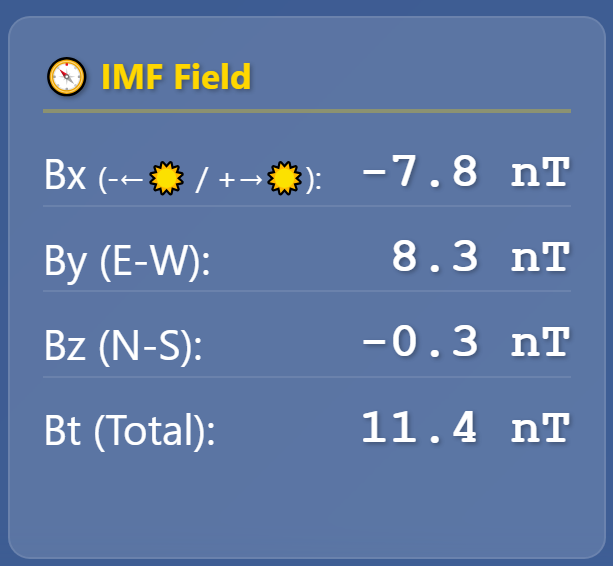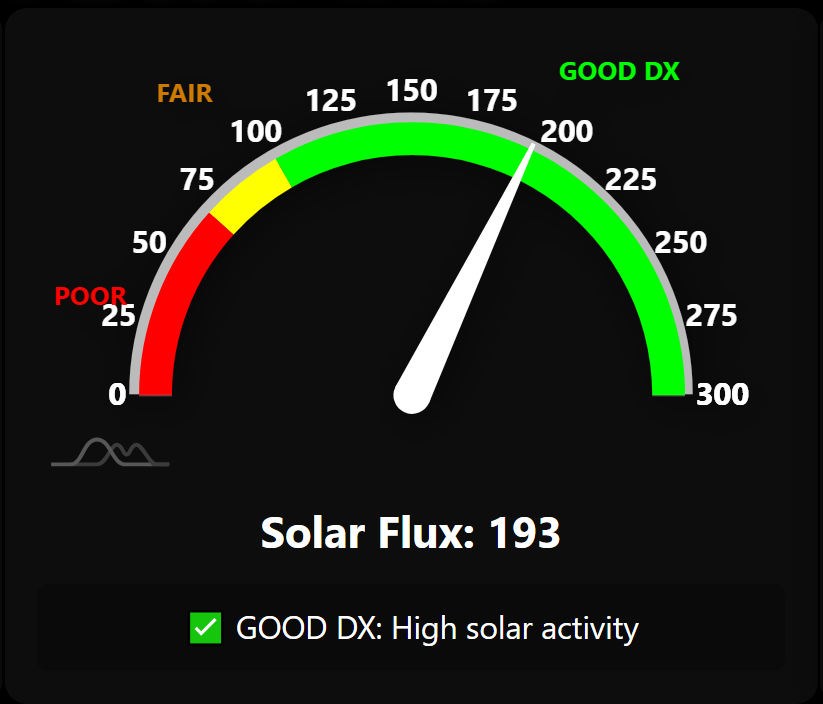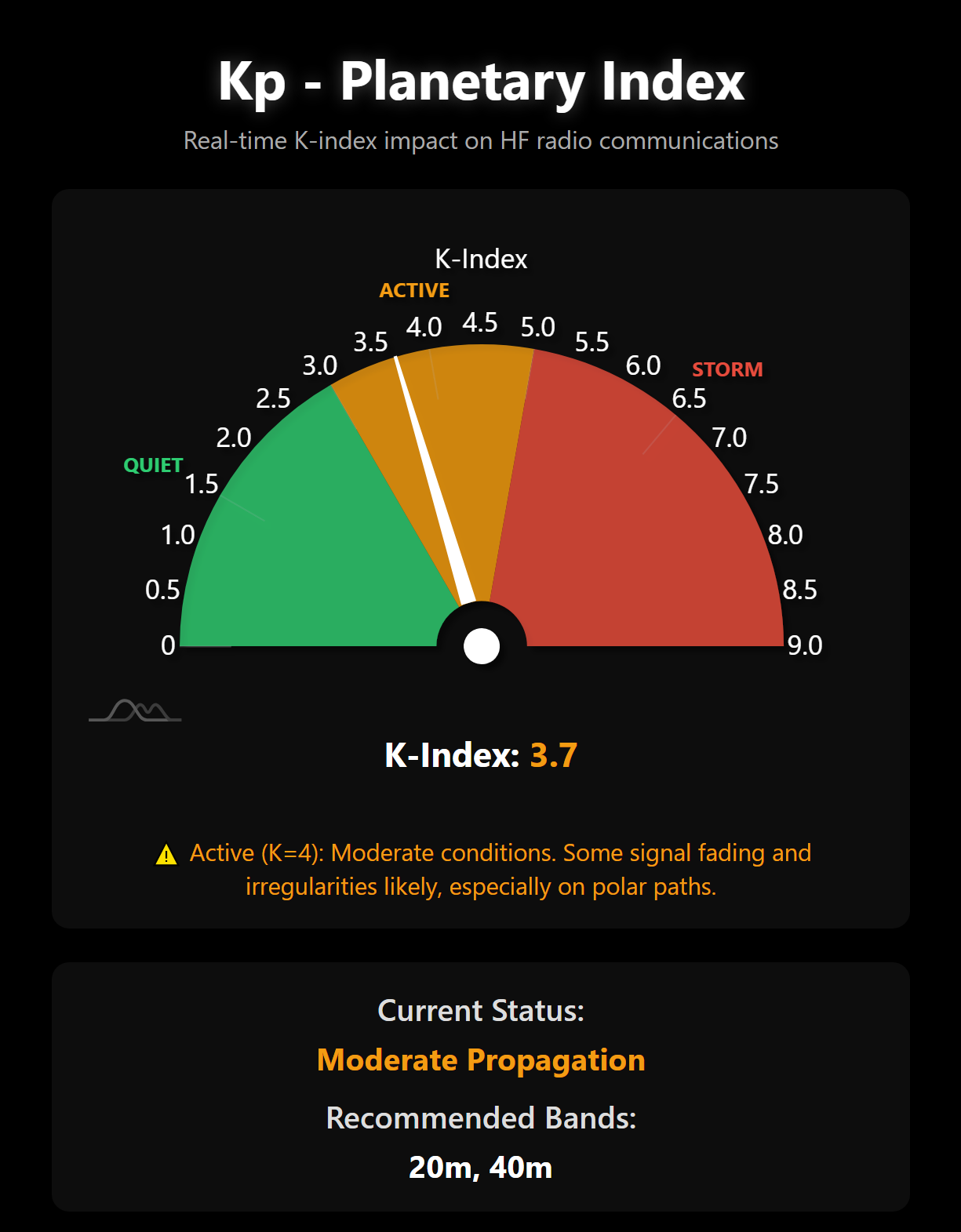Why Your Favorite Metric Keeps Lying to You
If you’ve been around the bands long enough, you’ve probably got a “lucky number.” Some hams swear by the Solar Flux Index. Others won’t get on the air until the Sunspot Number looks promising. A few keep one eye glued to Bz orientation, waiting for it to flip north. And of course, everyone panics when an X-class flare alert pops up.

Here’s the problem: propagation isn’t a horoscope. There’s no single number that can predict how your 20-meter DX window is going to behave this afternoon.
Space weather is messy, dynamic, and full of interactions, things like solar wind, at high speed, slams into IMF orientation, geomagnetic storms bend paths north and south, flares knock out HF on the daylight side while auroral openings bloom in the dark.
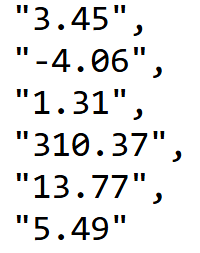
Relying on one or two metrics? You’ll wind up staring at a bunch of numbers in a text file and then say “things look great” while the bands are stone dead, or worse, that’s when you miss the best opening of the week because you trusted the wrong indicator.
That’s exactly why SolarCdx.com doesn’t stop at numbers. Our instruments don’t just show you SFI or SSN in isolation, they can, of course, but it’s much more. They correlate multiple drivers in real time and translate them into gauges, planners, and timelines that tell you what’s actually happening right now, and what’s likely to happen next.
The Single-Metric Trap
Every ham knows someone who swears by a single magic number. For decades, the Solar Flux Index has been the favorite, it’s easy to understand and seems like a reasonable predictor of how energized the ionosphere is. A higher SFI means more ionization, which usually means higher MUFs and better HF conditions. Sounds good, right?
Until the moment it isn’t. You can have an SFI of 180 which is an excellent number by most standards, and still sit in front of a radio wondering why 20 meters is absolutely silent. The reason is simple: SFI only measures one part of the system, and the system has a lot more moving parts than that.
It’s not just SFI. The Sunspot Number is another crowd favorite, but it suffers from the same blind spot. It tells you about long-term solar activity, not what’s happening on your bands in the next two hours. Others hang on the Kp index, which is useful for geomagnetic conditions, but it’s an averaged, delayed measure. By the time Kp says the storm is here, the aurora has already wrecked your polar path.
And then there’s Bz, the interplanetary magnetic field orientation. For aurora chasers, Bz is gold, but only when it turns south, the show is on. But if you’re not chasing auroral DX, Bz alone doesn’t explain much about why your 40-meter ragchew is struggling.
Each of these metrics has its place. Each tells you something real. But none of them alone tells you enough. It’s like saying, it’s 75F today, that means rain. Silly, right?
Space Weather Is Messy (And That’s the Point)
Propagation is not a straight line from “one number is up, so the bands are good.” It’s a chaotic system where multiple drivers interact, sometimes reinforcing each other, sometimes canceling out.
Take the case of a Coronal Mass Ejection hitting Earth. By itself, that’s bad news. But whether it wrecks your bands depends heavily on Bz. If it turns south, the Earth’s magnetic field opens up and the CME energy pours in, kicking off geomagnetic storms. If it stays north, the same CME might glance off with minimal impact, changing the HF forecast dramatically.
Or imagine you’re eyeing that high sunspot count and thinking 10 meters is about to light up. Then, a sudden M-class flare happens. The flare pumps X-ray radiation into the D-layer, causing a total HF blackout on the sunlit side of the planet. Your “great number” just became meaningless for the next few hours.
Meanwhile, solar wind speed and plasma density play their own roles. A fast wind stream (CH HSS) from a coronal hole might not sound dramatic, but when paired with negative Bz, it can shift MUFs, create absorption zones, and ruin polar openings.
The point is simple: no single metric ever tells the full story. It’s the interplay: flare strength + Bz + solar wind + geomagnetic conditions, and about a hundred other factors, that determines whether you’re racking up QSOs or calling into the void.
The SolarCdx.com Solution: Correlation in Action
This is exactly why SolarCdx.com exists >> to cut through the noise of single metrics and show you the whole picture. Instead of forcing you to juggle half a dozen charts, the SolarCdx.com system pulls them together, weighs them in real time, and displays the outcome in clear, operator-focused instruments.
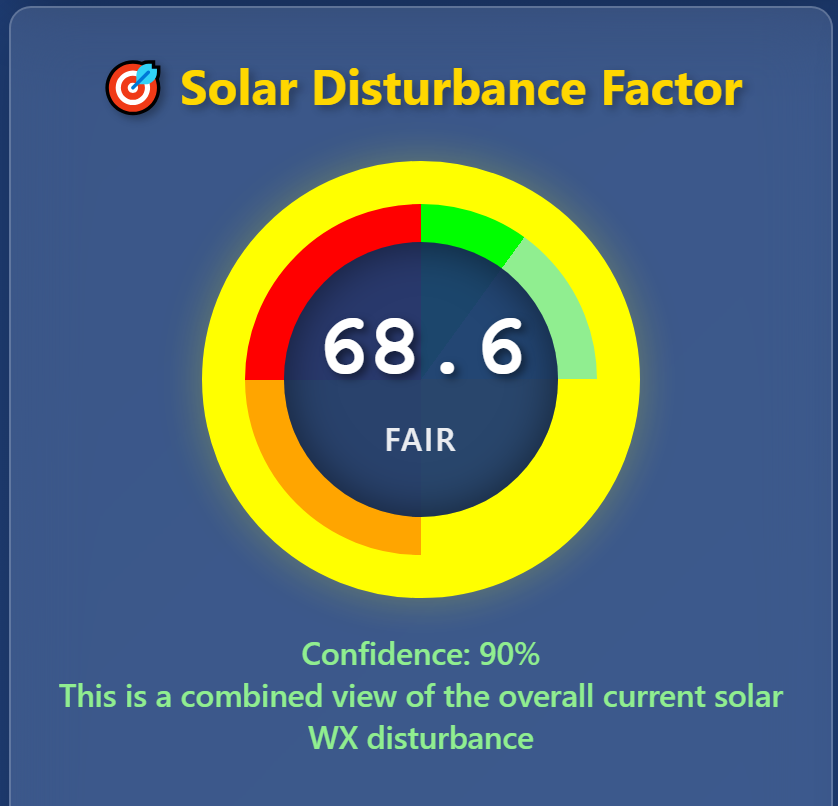 Take the Solar Disturbance Factor. It doesn’t just show you SFI or Kp; It’s way more…. factor in solar wind, IMF Bz, flare activity, and over 100 correlation metrics that give you a quick, composite view of current HF readiness. One glance, and you know whether 15 meters is worth trying right now, or whether you’re better off checking 40m.
Take the Solar Disturbance Factor. It doesn’t just show you SFI or Kp; It’s way more…. factor in solar wind, IMF Bz, flare activity, and over 100 correlation metrics that give you a quick, composite view of current HF readiness. One glance, and you know whether 15 meters is worth trying right now, or whether you’re better off checking 40m.
The Dynamic HF Band Planner goes a step further. Unlike traditional propagation predictions that give you a static forecast, the planner updates live as solar conditions shift. A flare spikes?  The planner adjusts. Bz goes negative? Recommendations change on the fly. It’s not a guess, it’s a real-time reflection of what the ionosphere is doing right now.
The planner adjusts. Bz goes negative? Recommendations change on the fly. It’s not a guess, it’s a real-time reflection of what the ionosphere is doing right now.
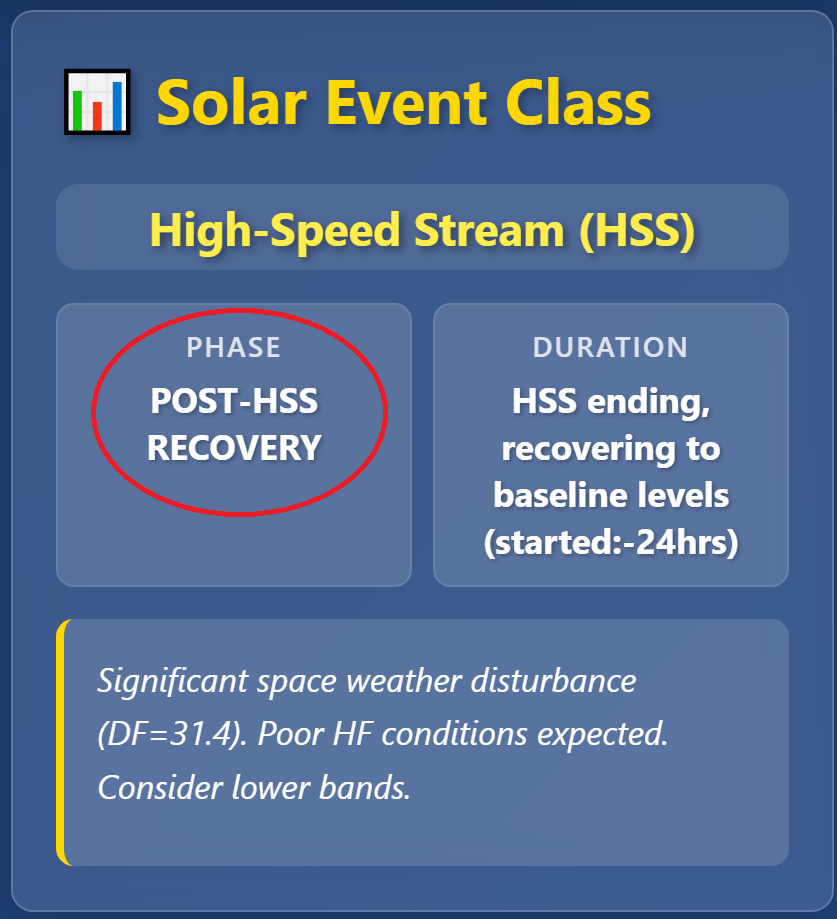 And then there are the Storm Phase Event Timelines. These map the start, peak, and decay of solar events, flares, CMEs, and storm recoveries so you can see not just what’s happening now, but how long it’s likely to last. Instead of blindly waiting for conditions to “get better,” you know whether recovery is minutes away or hours out.
And then there are the Storm Phase Event Timelines. These map the start, peak, and decay of solar events, flares, CMEs, and storm recoveries so you can see not just what’s happening now, but how long it’s likely to last. Instead of blindly waiting for conditions to “get better,” you know whether recovery is minutes away or hours out.
The difference is dramatic. Instead of checking your favorite number and hoping, you’re making decisions with context.
Real-World Scenarios Every Ham Knows
Situations you’ve probably lived through:
The Misleading Sunspot Number
SSN = 175. Everyone’s talking about how great conditions will be. You fire up 20 meters during the contest, only to watch the band go dead as an M5 flare hits. Without knowing the flare was coming and seeing how it interacts with solar flux your “lucky number” was useless.
The Silent Polar Path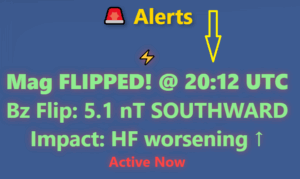 Kp=2, so you think the polar openings are safe. But Bz suddenly dives south to -5.1 nT, and your northern QSOs vanish in minutes. SolarCdx.com’s correlation engine would have flagged the risk the moment Bz flipped. It’s not just going South, ITS HOW MUCH, and HOW FAST (trend). Knowing that a little South is ok, the system adjusts. The other guys are still calling CQ, you’ve changed bands and are making contacts.
Kp=2, so you think the polar openings are safe. But Bz suddenly dives south to -5.1 nT, and your northern QSOs vanish in minutes. SolarCdx.com’s correlation engine would have flagged the risk the moment Bz flipped. It’s not just going South, ITS HOW MUCH, and HOW FAST (trend). Knowing that a little South is ok, the system adjusts. The other guys are still calling CQ, you’ve changed bands and are making contacts.
The Surprise Opening
A flare finally fades, and the D-layer absorption lifts. Suddenly 15 meters lights up with DX you weren’t expecting. Most hams, still staring at yesterday’s SFI, miss it. SolarCdx.com’s band planner, already showing improving conditions, catches it in real time.
Propagation wins and losses hinge on the mix of conditions, not a single number.
The Operator’s Advantage
This isn’t about collecting more data, it’s about making better use of the time you have. Most hams don’t spend twelve hours a day on the air. You’ve got limited windows: evenings after work, a Saturday contest, a few hours during a DXpedition opening.
Do you really want to waste that time calling CQ into a dead band because your favorite metric looked good? Or worse, miss the best opening of the week because it didn’t?
By combining metrics into meaningful instruments, SolarCdx.com gives you:
- More QSOs per hour – because you’re operating when conditions really support it.
- Fewer surprises – sudden flares or Bz flips don’t blindside you.
- Confidence – you know why conditions are good or bad, not just ‘the bands suck’.
- Smarter strategy – whether you’re DXing, contesting, running QRP, or practicing emergency comms, you can plan around reality, not guesswork.
Stop Treating Propagation Like a Horoscope
Your favorite metric isn’t lying, it’s just incomplete. Treating propagation as if it’s one number that could tell the whole story is like reading your zodiac sign and assuming it’s a forecast.
SolarCdx.com isn’t here to give you another number. It’s here to give you the picture. Real-time instruments. Actionable insights that actually make sense.
So stop hoping today’s SSN, SFI, or Bz value will magically predict your QSOs. Start looking at the full system. Because in ham radio, as in life:
Numbers are nice. Do WHATEVER wins QSOs.

